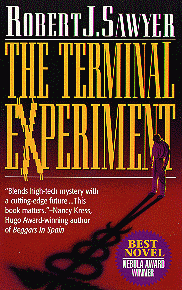When is an organ donor dead?
by Rob - August 4th, 2006.Filed under: Uncategorized.

That provocative question was the springboard for my 1995 novel The Terminal Experiment, which went on to win the Nebula Award: how do we decide whens someone is gone for good, so that it’s appropriate to harvest their organs. Here’s a snippet from that book:
“Let’s go,” said Mamikonian.
A nurse moved in and injected something into Enzo’s body. She spoke into a microphone dangled on a thin wire from the ceiling. “Myolock administered at 10:02 a.m.”
Dr.Mamikonian requested a scalpel and made an incision starting just below the Adam’s apple and continuing down the center of the chest. The scalpel split the skin easily, sliding through the muscle and fat until it banged against the breastbone.
The EKG shuddered slightly. Peter glanced at one of Hwa’s monitors: blood pressure was rising, too.
“Sir,” said Peter. “The heart rate is acting up.”
Mamikonian squinted at Peter’s oscilloscope. “That’s normal,” he said, sounding irritated at being interrupted.
Mamikonian handed the scalpel, now slick and crimson, back to the nurse. She passed him the sternal saw, and he turned it on. Its buzzing drowned out the blipping from Peter’s EKG. The saw’s rotating blade sliced through the sternum. An acrid smell rose from the body cavity: powdered bone. Once the sternum was cut apart, two technicians moved in with the chest spreader. They cranked it around until the heart, beating once per second, was visible.
Mamikonian looked up. On the wall was the digital ischemic counter; it would be started the moment he excised the organ, measuring the time during which there would be no blood flowing to the heart. Next to Mamikonian was a plastic bowl filled with saline. The heart would be rinsed in there to get old blood off it. It would then be transferred into an Igloo container filled with ice for the flight to Sudbury.
Mamikonian requested another scalpel and bent down to cut through the pericardium. And, just as his blade sliced through the membrane surrounding the heart–
The chest of Enzo Bandello, legally dead organ donor, heaved massively.
A gasp escaped from around his ventilator breathing tube.
A moment later, a second gasp was heard.
“Christ–” said Peter, softly.
Mamikonian looked irritated. He snapped his gloved fingers at one of the nurses. “More Myolock!”
She moved in and administered a second shot.
Mamikonian’s voice was sarcastic. “Let’s see if we can finish this damned thing without the donor walking away, shall we, folks?”
It’s still a gray area today, more than a decade later, as this story entitled “Not brain-dead, but ripe for transplant” from the August 4, 2006, New Scientist makes clear — and, interestingly, the test case they’re talking about involves a vehicular accident in Ontario, just like the one in the opening of The Terminal Experiment.

